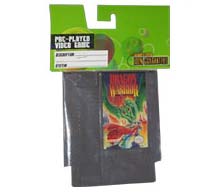Dragon Warrior has come to be known commonly as the granddaddy of RPG’s. All of the fundamentals of RPG games were present in this game: the ability to level up and upgrade weapons, multiple towns, multiple quests, and insane quests. All these and more were found in Dragon Warrior. It also set a few boring standards, such as the need to level up for certain dungeons and the eternal quest for money. Both of these add hours of (unwanted) playing time. By the time the Dragon Warrior series came to America, the foundations of RPG’s were already standards in newer and, dare I say, better RPG’s like Final Fantasy which was released the same year as Dragon Warrior in America.
The Dragon Quest series, what Dragon Warrior is called in Japan, is so popular that it can only be sold on days school is off, otherwise too many students will skip school to buy it. In America however, the series is not as feverishly received, with Dragon Warrior five and six not even released in America. Finding the American NES cartridges for parts two through four will be a tough quest in itself.
Dragon Warrior had a paper-thin “save the princess and eradicate evil” quest in it. It was very nice of Enix to introduce both RPG plot clich?s. Talking to townspeople and a few small side quests helped keep the story moving. Not too much was going on in terms of world politics, it all was either “save the princess” or “woe is us, DragonLord is destroying the land,” but the small tidbits of information given out by random townsfolk made talking necessary. The big bonus is the proper English translation, especially considering many next-generation games struggled with the task of translating.
Just because the translation to old English was done well doesn’t mean there was a clear and concise path through the game. Some people liked the idea of random exploring to ascertain what’s next on the agenda checklist; I personally did not. Exploration was fun, and being able to roam freely in an RPG is second to none, but not having a clue where to go over half the time was a bit aggravating, not to mention cumbersome.
Most RPG’s have a cult following, and Dragon Warrior has been no exception, with a small difference; the art in the game is exceptionally well known because it had a worldwide artist helming it, Akira Toriyama, otherwise known as the artist for Dragon Ball Z. Some might have heard of it. Akira Toriyama designed the monsters and characters in Dragon Warrior. His style was not too apparent because of the 8-bit graphical limitations. The graphics in general were acceptable but a bit bland. Having the hero equip a sword or shield will equip him with one on his character sprite also, a nice small touch.
The dungeons held an interesting concept that most games didn’t pick up on: using torches to light the way. If a torch was not lit, or a light spell was not cast, then the only visible item on the screen was the hero. If a torch was lit, then all squares immediately around the hero were lit. Limited lighting forced mapping dungeons and careful planning instead of brawling through a straight line filled with treasure laden with dead ends.
Dragon Warrior‘s combat was presented in a first-person point of view, something that will not change throughout the Dragon Warrior legacy. This had cut out almost any type of flashy animation for magic or special attacks, instead relying on colorful looking enemies to keep gamers occupied. Unfortunately, Dragon Warrior also fell victim to another standard of palette swapping enemies instead of creating new ones.
Sounds in this game were appropriate. With swings and hits that may not sound like a real sword cutting through gelatinous ooze, they did a good job nonetheless. Dragon Warrior‘s music, though, suffered from a lack of any variety, and begged to be turned off after a few hours. That was not to say that the music is not done well, rather Dragon Warrior served as a reason RPG music needs to be done differently to keep someone playing. But no one would want to hear the same four-minute song for twenty-five hours.
There was nothing extra to shoot for in Dragon Warrior, and once it was beaten, there’s nothing that compels a second trip, nor were there any secret weapons or shortcuts. This game was as linear as it could get. That being said, a game with over ten hours of playtime was well worth the effort in the early entries of the NES era. Dragon Warrior set the original bar for RPG’s and has remained an enjoyable, albeit long, quest to conquer evil.
